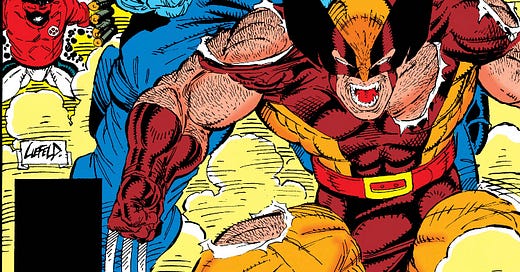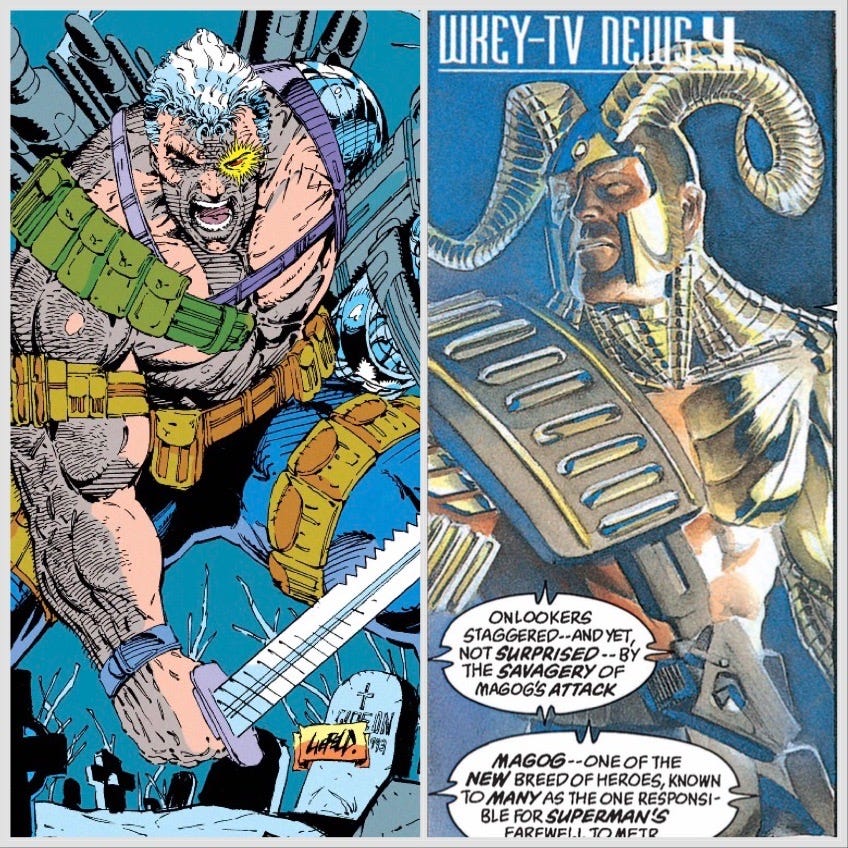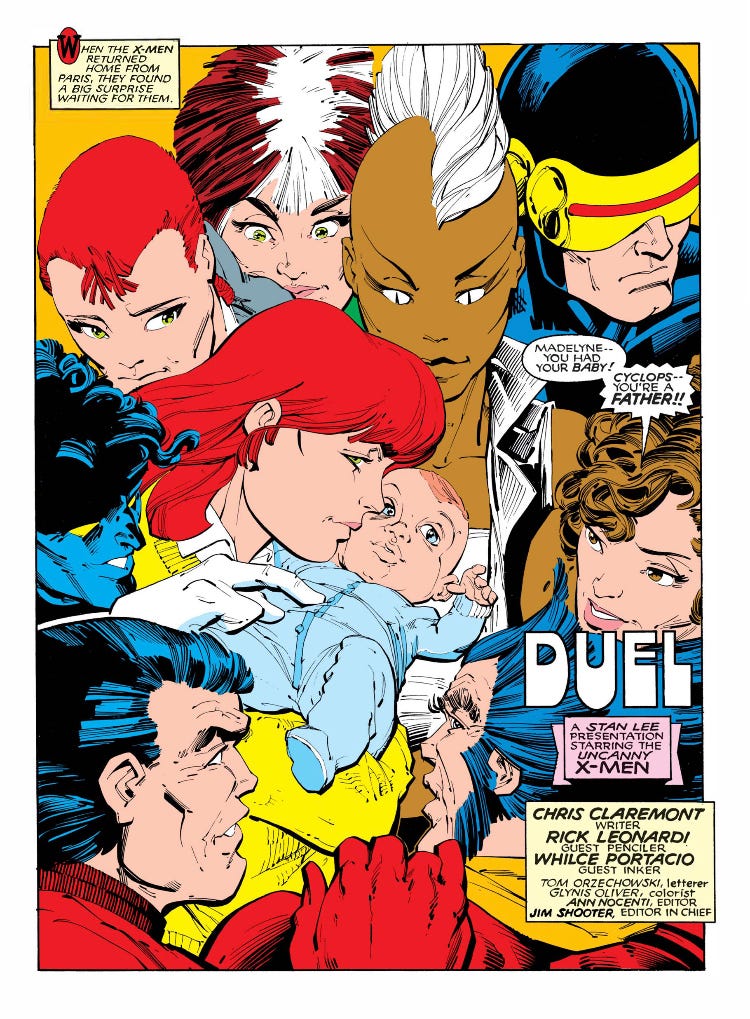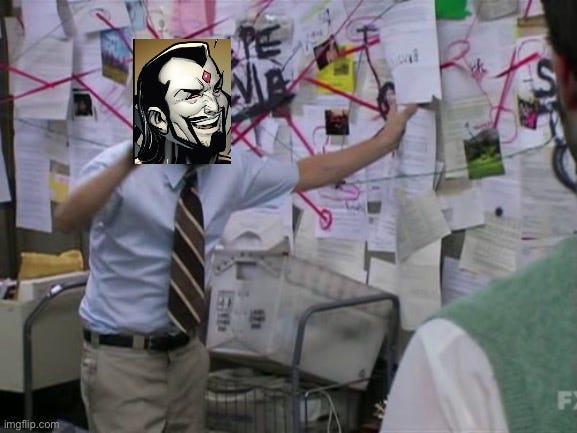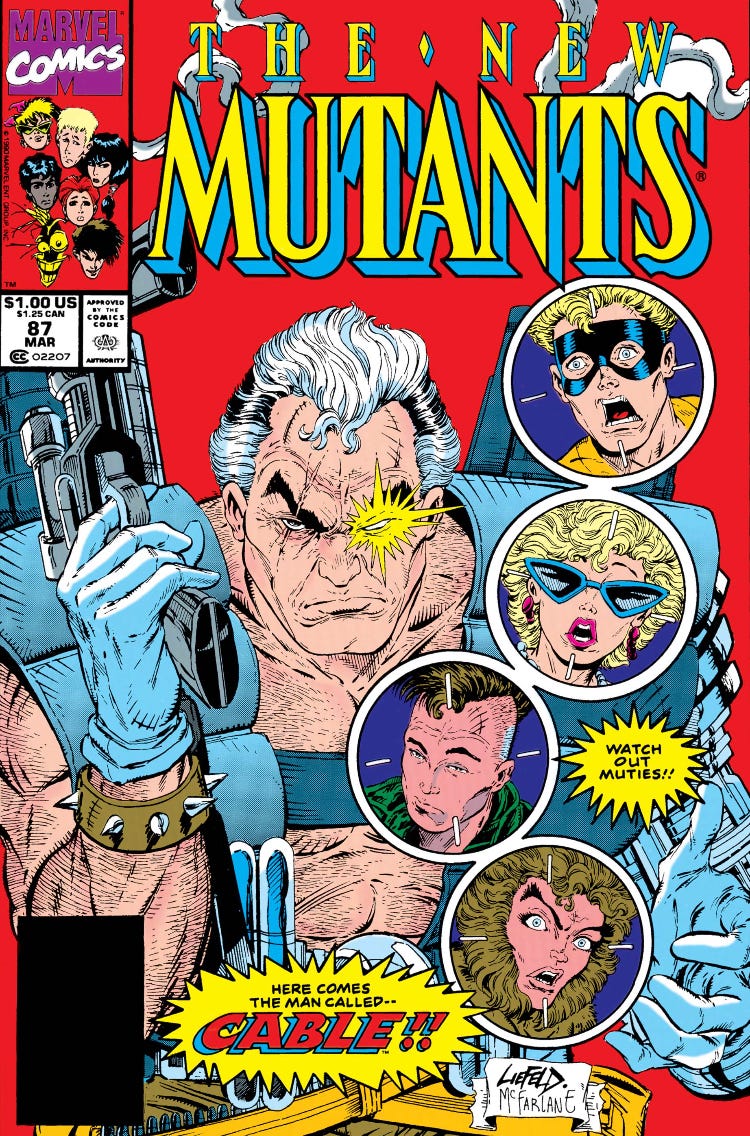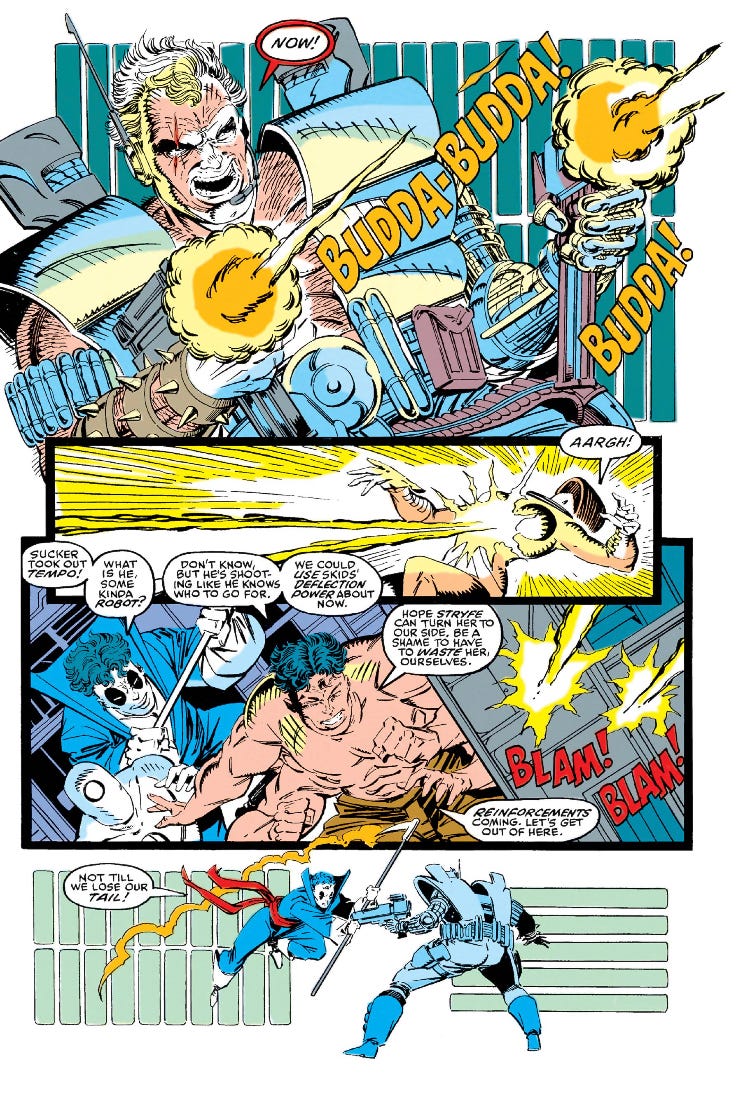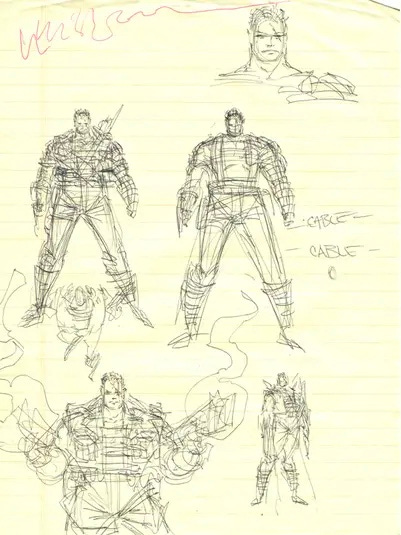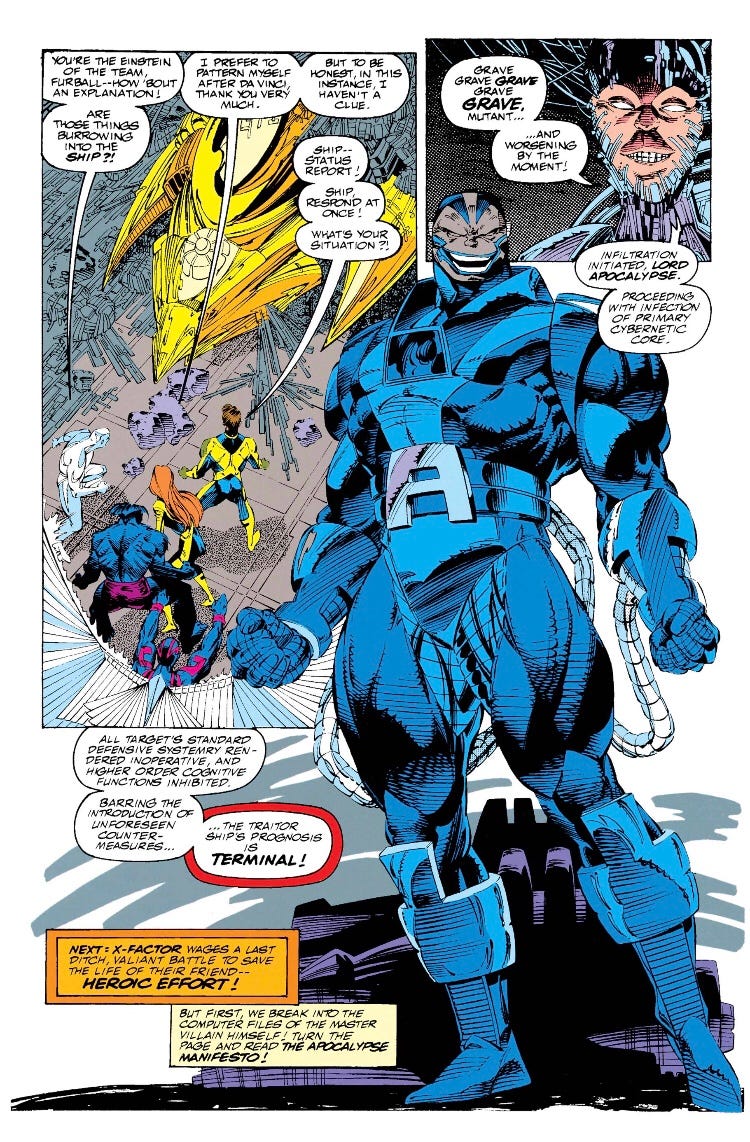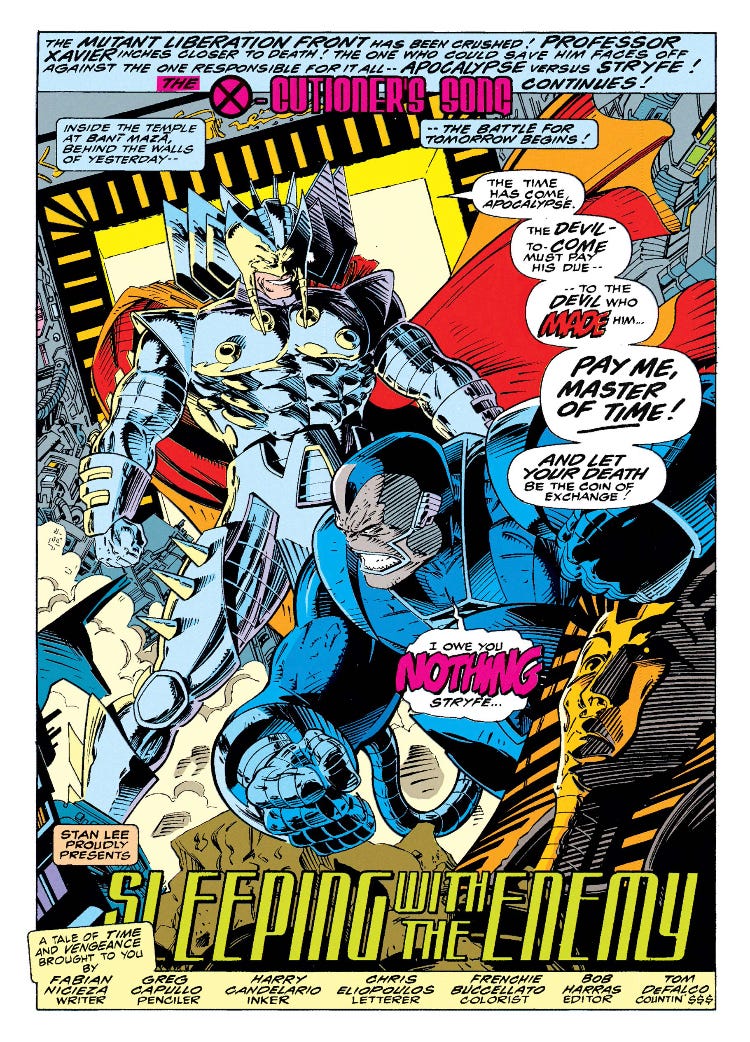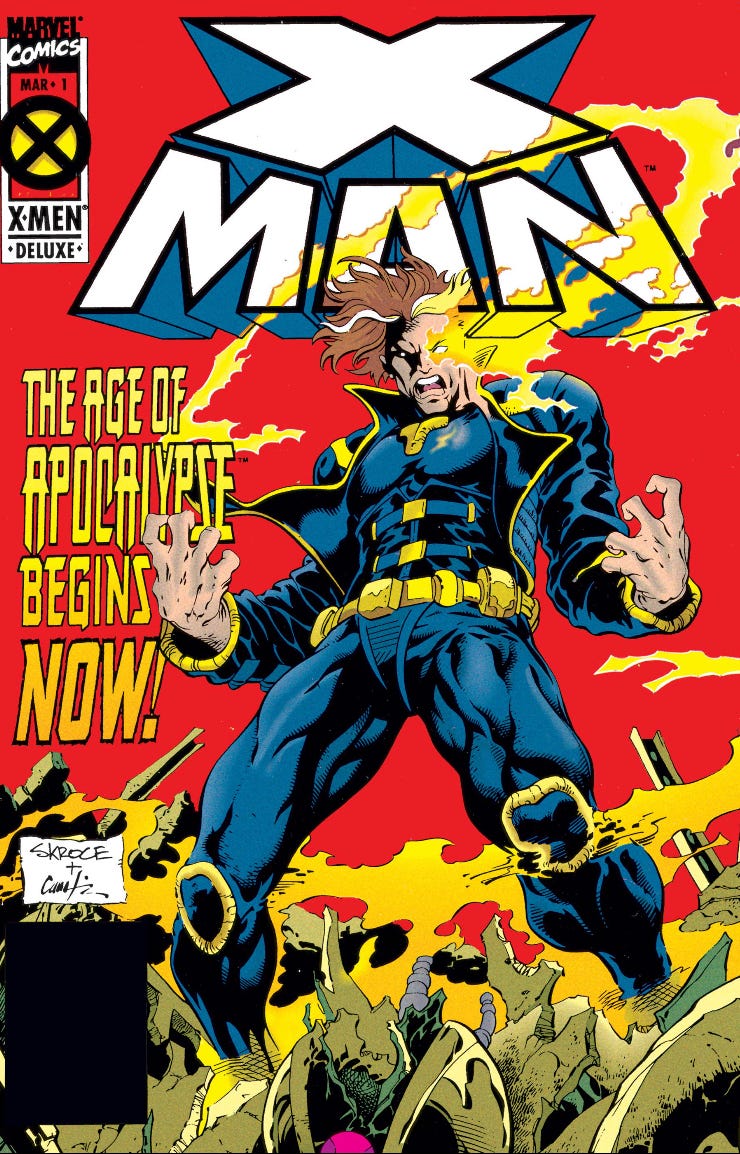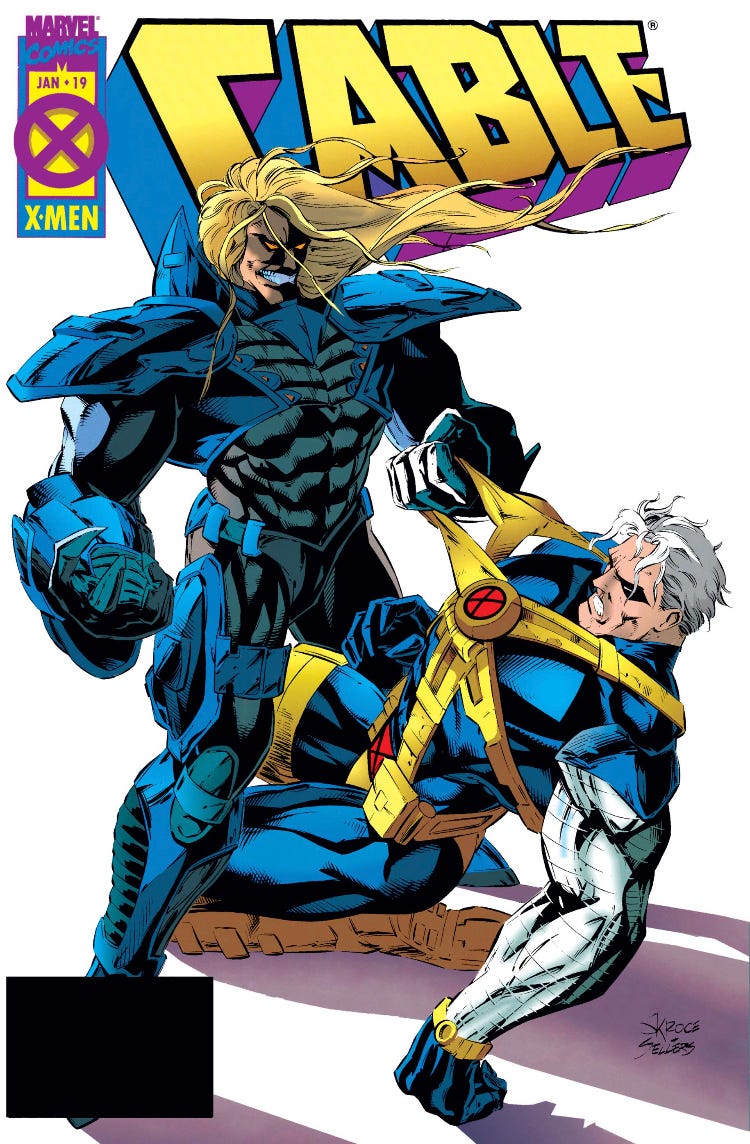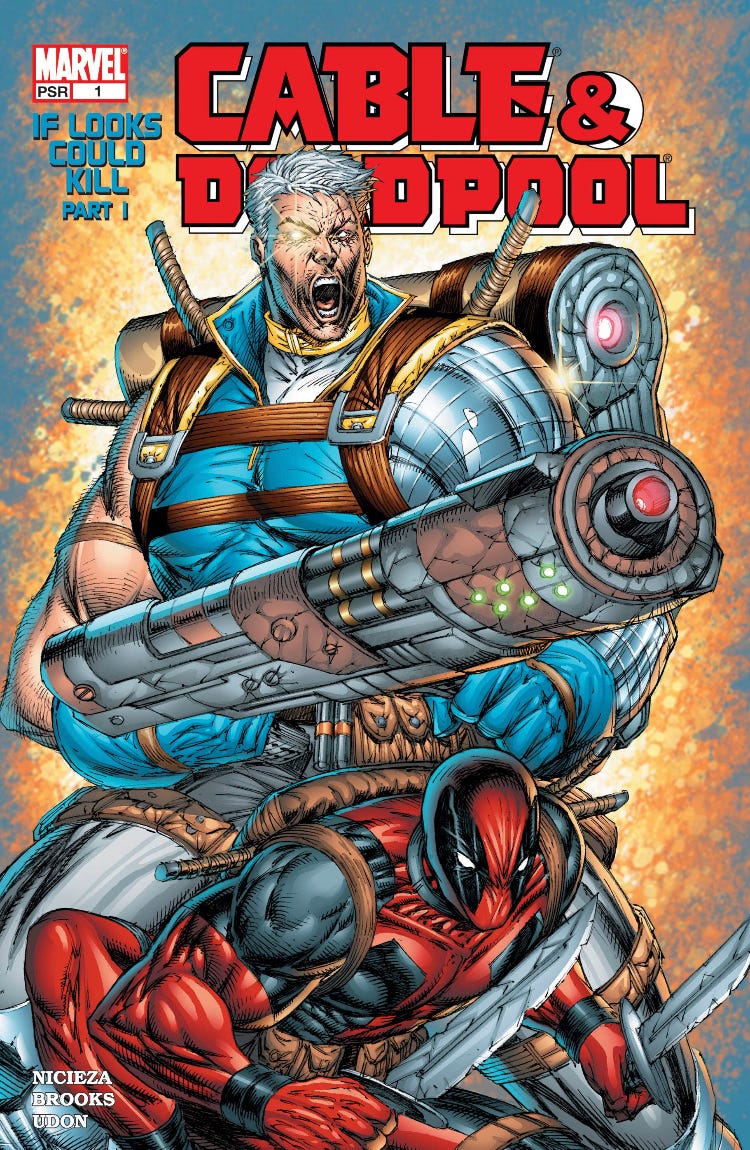X-Men X-Plainer: Cable
Nathan Christopher Charles Dayspring Askani’son Summers if you’re N'astirh
If there was one character who should serve as the poster child for ‘90s superhero comics, it would have to be Cable. He embodies the extreme grim and gritty comics that epitomized the decade both in terms of characterization and appearance. Cable was so synonymous with that prevailing style that the character of Magog that was created by Mark Waid and Alex Ross to satirize ‘90s antiheroes in Kingdom Come is little more than a carbon copy of Cable with a helmet.
Yet despite being so much a product of his time, Cable continues to be one of the most popular characters in the X-Men line. He’s even getting a brand new limited series this week from Fabian Nicieza (who has probably written more comics featuring Cable than any human alive) and Scot Eaton. How has this character managed to maintain his popularity for nearly thirty-four years while so many other characters from the ‘90s have fallen out of favor with readers? I suspect that part of the reason is due to how he is so thoroughly woven into the DNA of the X-Men as a whole, so let’s take a trip back through the publication history of Marvel’s premiere super team and how Cable came to play such an integral role. Spoilers ahead for…basically every X-Men comic ever published.
The story begins with the launch of Uncanny X-Men #1 in 1963 from Stan Lee and Jack Kirby. I know the “uncanny” wasn’t added to the title until issue #142 in 1980, but I’m trying to minimize as much confusion as possible when it comes to which series I’m referring to because this is going to become very confusing as it goes. Anyway, that issue introduces the five original X-Men (Cyclops, Marvel Girl, Angel, Beast, and Iceman) along with Professor X and Magneto. I’m going to be focusing on Cyclops (Scott Summers) and Marvel Girl (Jean Grey). Get used to characters with the surnames Summers and Grey. The two officially became a couple in Uncanny X-Men #32 by Roy Thomas and Werner Roth in 1967, and they would continue to be the foremost mutant couple throughout the Silver Age and into the Bronze Age. Jean would eventually become the host of a cosmic entity called the Phoenix in Uncanny X-Men #101 by Chris Claremont and David Cockrum in 1976. Her time spent as a godlike cosmic being culminated in the beloved “Dark Phoenix Saga” from Claremont and John Byrne that ultimately ended with her death in Uncanny X-Men #137 in 1980. It’s one of the most famous comic book stories of all time, and it has been adapted by the same guy on two separate occasions into terrible movies.
Cyclops would quit the team in the following issue, and he would eventually find love again in the form of a woman named Madelyne Pryor in 1981’s Uncanny X-Men #170 by Claremont and Paul Smith. Maddie bore an uncanny (sorry) resemblance to Jean Grey and even sounded like her according to Scott. Maybe not the healthiest relationship to jump into following the death of your girlfriend. Regardless, Maddie and Scott would end up getting married in Uncanny X-Men #175 by Claremont, Smith, and John Romita, Jr. Maddie would later reveal that she was pregnant with Scott’s baby in X-Men and Alpha Flight #1 by Claremont and Smith in 1985. Maddie would end up giving birth to Nathan Christopher Charles Summers in Uncanny X-Men #201 by Claremont and Rick Leonardi. Things are looking up for these two love birds! Surely nothing will ever go wrong.
In X-Factor #1 (1986) by Bob Layton and Butch Guice, Scott learns that Jean Grey is somehow alive. He does what any devoted husband and father would do, and he walks out on them with no explanation to go see his ex-girlfriend. Jesus, Scott. Meanwhile, we see in Uncanny X-Men #206 (1986) by Claremont and Romita, Jr. that Maddie has apparently been gunned down by an unknown assailant and rushed to a hospital as a Jane Doe. Maddie is comatose, and there is no sign of her baby. This got dark in a hurry. Scott would eventually return home to find his family missing, and all evidence and records of their existence completely vanished in X-Factor #13 (1987) by Louise Simonson and Walt Simonson. Very suspicious. Maddie finally awakens from her coma in Uncanny X-Men #215 (1987) by Claremont and Alan Davis, and it is here that we learn that the villainous Marauders (mutant mercenaries employed by the aptly named Mister Sinister) were the ones responsible for kidnapping Nathan and putting her in a coma. Her story picks up in Uncanny X-Men #221-222 (1987) by Claremont and Marc Silvestri. These are two of my favorite X-Men comics ever published. Maddie has called the X-Men for help at about the same time Sinister realizes that the Marauders botched the hit on her that he ordered. The two teams of mutants arrive at the hospital at the same time, and a vicious battle ensues depicted by Silvestri’s magnificent artwork. It rules.
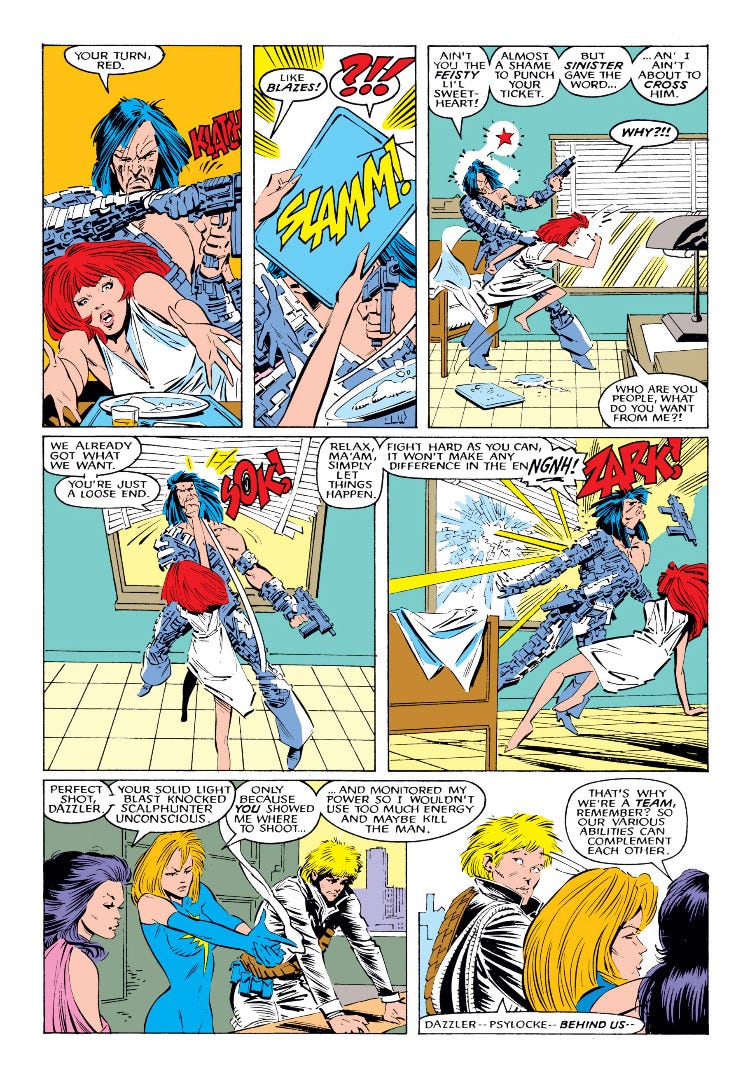
The X-Men succeed in repelling the Marauders, and Maddie joins the team with the hope that they can help her find Nathan. She also insists on not contacting Scott and letting him know she’s alive. Honestly? I don’t blame her. She later ends up sacrificing herself along with the other X-Men on national television to defeat a villain called the Adversary in Uncanny X-Men #227 (1988) by Claremont and Silvestri. Don’t worry. They get better. That said, Scott learns his wife is alive by seeing her on national television right before she seemingly dies. Brutal.
Anyway, Maddie and the X-Men are actually alive and operating out of the Australian Outback for the remainder of the 1980s. This is where things start to get wild. Yes, I’m saying that what has already been covered isn’t wild by comparison. Maddie sees Scott on a giant television screen with Jean Grey one day, and she responds by punching it and knocking herself unconscious from the resulting electrical current. Once again, I can’t blame her. While unconscious, a demon named S’ym from the realm of Limbo invades her mind and gives her a nightmare where she is rejected by Scott who begins stealing the features off of her face and body to construct Jean Grey. He then leaves her for Jean and takes the baby too. I think this might be a metaphor for something, but it’s impossible to say. S’ym eventually makes his presence known and does the typical demon thing of making a bargain. This all takes place in Uncanny X-Men #232-234 (1988) by Claremont and Silvestri. Flashing ahead to Uncanny X-Men #239 (same creative team), and Maddie has now become a demonic powered entity calling herself Goblin Queen. She has made a deal with a demon named N’astirh where she will open a portal to Limbo on Earth in exchange for locating her child’s whereabouts and getting revenge on the Marauders. This kicks off the “Inferno” event that will run through every X-Men title being published at the time as well as several other Marvel books. It’s a massive event, so I’ll boil it down to the relevant details. Mister Sinister is the person in possession of Maddie’s baby. Turns out that he is basically a mad scientist with a eugenics-based obsession with mutants. He’s convinced that the Summers and Grey bloodlines are destined to produce a perfect mutant child, so he’s been working in the shadows to make sure Scott and Jean have a kid. That plan was complicated when Jean seemingly died at the end of the “Dark Phoenix Saga.” Undeterred, Sinister made a clone of Jean Grey and continued his little marionette show to coax Scott and this clone into having a baby. If you haven’t put it all together by now, I’ll do it for you: Madelyne Pryor is a clone of Jean Grey, and Nathan is this supposedly perfect mutant child.
This knowledge combined with the demonic tinkering causes Maddie to completely snap and attempt to murder her own child along with the X-Men (and pretty much all of humanity if we’re being honest). She is ultimately defeated and dies in a very complicated way involving a piece of the Phoenix that was inside of her, but this is not a Madelyne Pryor piece. This is a Cable piece, so let’s keep it moving (though Connor Goldsmith has put out around eighteen hours of content dedicated exclusively to Madelyne Pryor on his excellent Cerebro podcast if you’d like to know more about her). All of this took place in Uncanny X-Men #239-243 by Claremont and Silvestri and X-Factor #35-39 by the Simonsons from 1988-89. A lot of people (myself included) consider the 1980s to be the best decade for X-Men comics with Claremont and Simonson crafting some of the greatest stories of any era and artwork that is flat out spectacular for the entire decade. “Inferno” signified the end of the decade and a shift into the next one where the comic book industry as a whole was going to dramatically shift.
The end of the 1980s saw the rise of a new batch of artists at Marvel Comics. This new crop of artists had a much different style than the traditional “house style” that was common throughout the 1970s and first half of the 1980s. These newer artists included the likes of the previously discussed Marc Silvestri along with folks like Todd McFarlane, Jim Lee, Erik Larsen, Whilce Portacio, Jim Valentino, and others. Any titles these artists worked on saw an increase in sales, so they began to be placed on more and more books. One such artist would be paired with Louise Simonson starting with New Mutants #86 in 1990. His name is Rob Liefeld. I know. Even casual fans of comic books are well acquainted with him. Few figures in the history of comic books are as divisive as Rob Liefeld, and nothing I say in this piece is likely to shift your opinion of him in one direction or another. With that in mind, the story behind the subject of this little piece is impossible to tell without some controversy behind the scenes.
Cable made his debut in New Mutants #87 (1990) by Louise Simonson and Rob Liefeld. The first thing you might notice about him on the cover of that issue (inked by Todd McFarlane!) is that he looks significantly different than the other characters in the book. For starters, he is much older than the rest of the New Mutants. These characters are all teenagers, and suddenly in walks a guy appearing to be in his sixties at the youngest. He has gray hair with a receding hairline and a scarred face. Secondly, the dude is armed to the teeth. The characters in X-Men comics typically don’t wield guns because they have superpowers. On top of the guns and tactical gear, Cable also has what appears to be a robotic (or at the very least metallic) left arm. His appearance, demeanor, and attitude can basically be boiled down to a cross between the Terminator and Dirty Harry. He is introduced by fighting a new team of villains called the Mutant Liberation Front led by a new villain named Stryfe.
It’s a completely different look and feel than anything that had appeared in any of the previous eighty-six issues of New Mutants. I imagine anyone who had been reading New Mutants regularly up to this point had to consult their doctors with a case of severe whiplash. Over the course of the next several issues, Cable would become the new leader of the New Mutants and work to train them into a squad of soldiers capable of fighting the Mutant Liberation Front and other threats. What led to such a radical change to the book? Different people have different accounts of what took place, but I’ll go with the version of events laid out by Walt Simonson on more than one occasion.
For those unaware, Walt Simonson and Louise Simonson are married. They have both worked in the comic book industry for decades at this point, and they famously collaborated on X-Factor throughout the 1980s with Louise writing and Walt illustrating. In 1990, Louise Simonson had already been writing New Mutants regularly since 1987 with Rob Liefeld just being Introduced on the title as the penciler. Editor Bob Harras had wanted a new leader to be introduced to the book whose tactics and worldview would be more militant than that of Professor X. As an aside, I’d like to point out that Magneto had been the leader of the New Mutants from 1986-89. If Harras wanted a leader who was more militant than Professor X, then why didn’t he just insist that Magneto remain the leader? Oh well. Simonson reportedly wanted the new leader to be more of a soldier type, and Liefeld sketched out some character designs.
Harras apparently preferred the character design that would go on to be Cable. Simonson started writing scripts featuring the character that she named Commander X. Liefeld suggested renaming him Cable, and Simonson agreed. Liefeld also designed and named Stryfe at this time who would become Cable’s chief nemesis. Walt suggests it was Louise who wanted to make Cable a time traveler from the future, but I know Liefeld has been pretty adamant about being the one who came up with his backstory over the years. Regardless, Cable would be introduced as a figure with a mysterious past that would slowly be revealed issue by issue.
Simonson and Liefeld would remain the creative team on the book up until New Mutants #98 (1991) when Simonson would leave the series. Liefeld was essentially handed creative control at this point as both the artist and plotter with Fabian Nicieza coming on board as the scripter. Liefeld would begin phasing out some of the core members of the New Mutants that had been on the team since the ‘80s in favor of new characters Liefeld was creating with Nicieza. Both Deadpool and Domino made their debut in New Mutants #98. The characters of Feral and Shatterstar debuted the following month in New Mutants #99, and the existing character of James Proudstar would adopt the name Warpath and join the team in that same issue. The series would be canceled with issue #100, and the series would be rebooted and rebranded as X-Force #1 in August of 1991.
It would sell a staggering five million copies when it debuted which was a record for most copies of a single issue of an American comic book ever sold at that time (a record that would be broken two months later by X-Men #1 by Chris Claremont and Jim Lee with over eight million copies sold). It is still the second highest selling American comic book of all time as of 2024. By this time, Cable had become one of the most popular comic book characters in the world. X-Force was a Cable book for all intents and purposes, and each issue focused on bombastic action sequences courtesy of Liefeld’s art and plots. Most of these action sequences revolved around Cable’s X-Force fighting Stryfe’s Mutant Liberation Front. It had been previously revealed in New Mutants #100 from Liefeld and Nicieza that Stryfe (who is always covered head to toe in the shiniest metal armor you’ve ever seen) was identical to Cable under his helmet. What does this mean?! Is Stryfe the long lost evil twin of Cable? Are they secretly the same person with different identities? Is this some kind of alternate universe situation? It was the number one mystery of X-Force while Liefeld was on the book. Liefeld’s plan was to reveal that Cable and Stryfe were actually the same person from different points in time. The idea was that Cable would eventually become corrupted and turn into the villainous Stryfe. Typical time travel shenanigans.
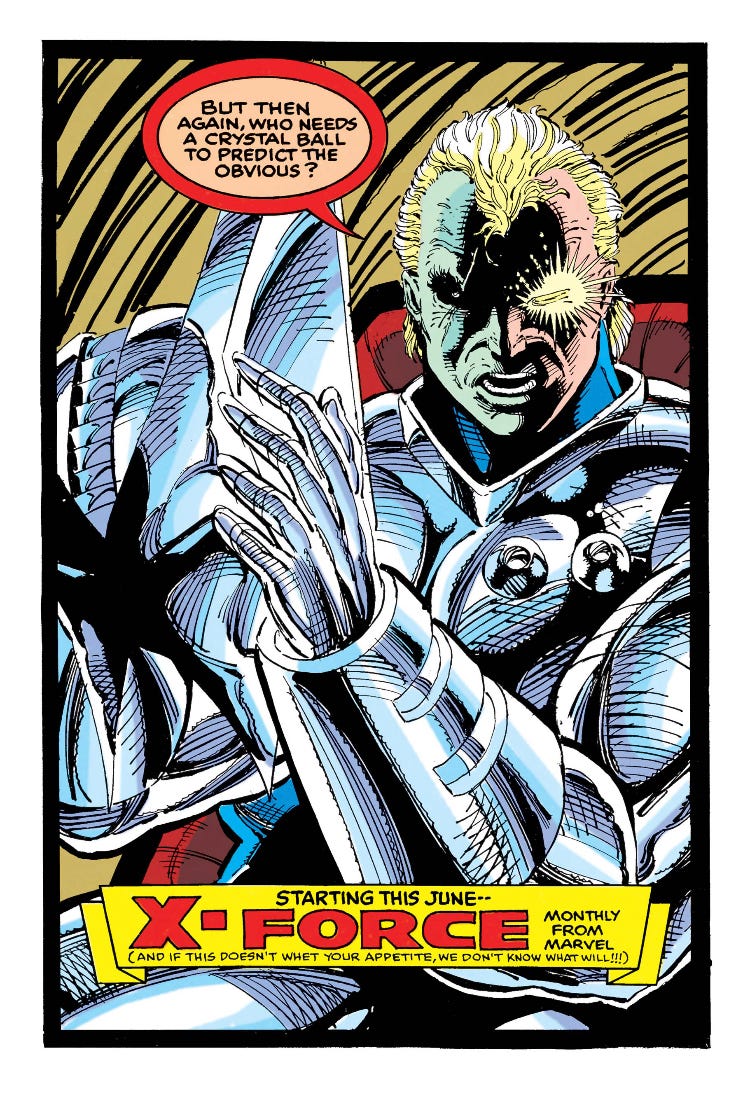
Despite knowing Liefeld’s plans for the character, editor Bob Harras and the artist/storyteller duo of Jim Lee and Whilce Portacio had other plans. X-Factor #65-68 (1991) was a four issue arc co-plotted by Lee and Portacio, scripted by Chris Claremont, and drawn by Portacio that set out to give Cable a different origin story. It’s a sprawling epic that sees X-Factor (Cyclops, Jean Grey, Beast, Iceman, and Archangel) team up with the Inhumans to fight Apocalypse and his Riders of the Storm on the Moon as the ancient Egyptian mutant attempts to abduct Nathan, the supposed perfect mutant child of Cyclops and Maddie Pryor. While this is happening, a time traveler from the 37th century named Jen Askani has traveled to the present to protect Nathan’s life. A big battle ensues, and Nathan is infected with a techno-organic virus that is slowly converting his flesh into living machinery. To save his life, Jen Askani takes him to the 37th century where he will be raised by a religious organization of freedom fighters called the Askani who view him as the messiah. Apparently Apocalypse rules the world with an iron fist in this distant future, and Nathan is the chosen one who will one day bring an end to his reign of terror. If it hasn’t already become clear, Cable is the adult version of Nathan who has traveled back in time to the present. This new development also doubles down on the Mister Sinister “perfect mutant” origins by making him a mutant messiah figure. It also explicitly ties him to Apocalypse despite having no interaction with the character in the comics up to this point.
1992 would serve as a monumental year for Cable, the X-Men line of comics, and really the comic book industry as a whole. There had already been a sea change at Marvel when legendary writers like Chris Claremont and Louise Simonson began to be replaced on the X-Men titles that they had guided throughout the 1980s by young superstar artists that rocketed to new heights in the 1990s (the aforementioned Rob Liefeld, Jim Lee, and Whilce Portacio being among them). After essentially being handed the keys to the bestselling properties at Marvel, these same artists would collectively leave the publisher to form Image Comics where they would own their own intellectual properties. This sent shockwaves throughout the industry, and it led to a lot of writers on the X-Men books going from “scripting” based on plots and stories the artists were crafting to being the ones crafting the plots themselves. The first big test for these new creative teams came in the form of a twelve-part crossover event called “X-Cutioner’s Song” that kicked off at the end of 1992 and continued into early 1993.
The narrative thrust of the event was Stryfe finally making his power play to crush all of his enemies and get revenge on those who wronged him. Stryfe believes himself to be the child of Cyclops and Madelyne Pryor who was sent to the future, and writer Fabian Nicieza had intended this to be the truth. Cable was planned to be revealed as a clone of Stryfe who had chosen a heroic path. All of the various mutant teams are involved (X-Men, X-Force, and X-Factor), but Cable serves as the de facto protagonist since Stryfe is his primary foe. The issues of X-Force are the standouts for me as Fabian Nicieza has the strongest grasp on writing Cable and Stryfe, and the artwork from new artist Greg Capullo is phenomenal. He gets the opportunity to draw the best fights and most iconic moments from the event such as a three-way brawl between X-Men, X-Force, and X-Factor in X-Force #16, a fight between Stryfe and Apocalypse in X-Force #17, and the final battle between Cable and Stryfe on the Moon in X-Force #18. The event concludes with both Cable and Stryfe appearing to die. Don’t worry. They’ll be back. You can always have time travelers return whenever you need them. Cable returns just in time for the “Fatal Attractions” event where he immediately gets absolutely wrecked by Magneto (a guy whose left side of his body is made of metal probably should have known better) in X-Force #25 (1993) from Nicieza and Capullo.
The next major development in Cable’s complex story would arrive in a miniseries called The Adventures of Cyclops and Phoenix (1994) from Scott Lobdell and Gene Ha. It’s a classic tale of the minds of Cyclops and Jean Grey being shot forward into the far future where they inhabit the bodies of their future descendants in a dystopian hellscape ruled by Apocalypse where they are tasked with raising their son Nathan who had been taken here back in X-Factor #68. This is the series where it is definitively stated that Nathan is Cable, and his clone is Stryfe. It’s a bizarre and truly bonkers science fiction story, but I loved it as a kid. It’s still a pretty fun read today as well. The key takeaways are that Cable is still believed to be the mutant messiah who will one day kill Apocalypse, Apocalypse is aware of this prophecy and wants to raise Cable as his heir so he can eventually transfer his essence into Cable’s stronger young body, and Apocalypse is mistakenly raising Stryfe whom he believes is Cable unaware that he’s a clone. Got all of that? One thing I haven’t really covered up to now is what Cable’s (and therefore Stryfe’s) mutant powers are. He almost exclusively relies on weapons and traditional combat in New Mutants and X-Force to the extent that it’s easy to forget that he’s a mutant at all. In actuality, Cable has extremely powerful telepathic and telekinetic abilities. The reason he so rarely uses them is that he focuses his attention on preventing the techno-organic virus from continuing to spread across his body (and eventually killing him). We get to see these powers on display in this series from both Cable and Stryfe as pre-teen kids. The series helps explain how Cable (raised by time displaced Cyclops and Jean) and Stryfe (raised by Apocalypse) turned out so very differently. The series concludes with Apocalypse being killed and Cyclops and Jean returning to their bodies in the present. This is also how Cable ends up with his full name of Nathan Christopher Charles Dayspring Askani’son Summers (always fun to type out).
Cable’s origin is even further elaborated on in The Further Adventures of Cyclops and Phoenix (1996) by Peter Milligan and John Paul Leon. This series explains that Mister Sinister was granted his immortal status and vast powers by Apocalypse when he was just a human scientist in England in 1859. It was this period of time when he first identified the Summers and Grey lines as having the potential to create the ideal mutant. In Cable Annual #1 (1999) by Mike Higgins, Karl Bollers, German Garcia, and Alitha Martinez, it is further explained that Sinister sought to create Cable through his eugenics program with the express purpose of creating someone who could kill Apocalypse.
The rest of the 1990s basically sees Cable going on various adventures that always seem to tie back to Apocalypse in one way or another. There were also two new characters introduced that theoretically should be important to Cable, but they don’t interact as much as you might expect.
One of these characters is Nate Grey (also known as X-Man). Nate Grey was created by Jeph Loeb and Steve Skroce in X-Man #1 (1995). He’s basically an alternate universe variant of Cable that spun out of the wildly popular “Age of Apocalypse” event that subsumed the entire X-Men line in 1995. Most of the different versions of these characters were killed off at the conclusion of the event, but a handful of the most popular characters ended up in the main continuity. All you really need to know about him is that he’s a younger version of Cable without the techno-organic virus, so he is able to fully utilize his vast telepathic and telekinetic abilities.
The other character is Tyler Dayspring (also known as Genesis). Genesis is yet another character from Cable’s past in the distant future who ends up in our time. He first pops up in a flashback in X-Force #1 from Liefeld and Nicieza, but it isn’t until Cable #19 (1995) by Loeb and Skroce that he is introduced as Genesis. He’s Cable’s son…maybe? Possibly Cable’s nephew? Potentially just someone Cable mentored? It’s not entirely clear, but he is a villain who resents Cable and fancies himself the heir to Apocalypse. It frankly doesn’t matter because he’s killed off by Wolverine only a year later in Wolverine #100 (1996) by Larry Hama and Adam Kubert.
The 2000s saw quite a shift in Cable’s direction in the comics. After being hyped throughout the ‘90s as the mutant messiah who would one day kill Apocalypse, it ends up being Cyclops who ultimately kills him in a very complicated event in 2000 called “Apocalypse: The Twelve.” I’m not going to go into detail on this one (maybe if I do a piece on Apocalypse one day), but the main takeaway for our purposes is that Cable has now been decoupled from Apocalypse. When you spend the better part of a decade saying a character is intrinsically tied to another character, what do you do when one of those characters has been taken off the board? It turns out you can do plenty of fun and interesting things! A new ongoing series written by Fabian Nicieza kicked off in 2004 called Cable & Deadpool that ran for an incredible fifty issues with a slew of different artists contributing throughout the run. It’s basically a buddy cop action-comedy series where Cable is the no nonsense straight man while Deadpool is the zany comic relief who is constantly annoying the hell out of him. It’s a very fun series! I think it’s one of the most important series for the continued popularity of the character for a couple of reasons. First off, it showed you can tell a good Cable story without steeping it in layers of complicated continuity and messianic cliches. He can just be a badass mutant soldier fighting the good fight. Secondly, it proved that Cable is more than just a cool drawing. One major criticism of ‘90s comics is that they are all style with no substance. You can have the coolest character designs anyone has ever seen, but they will have no staying power without strong characterization and storytelling. There is a reason you don’t see comic book series like Youngblood, Prophet, Brigade, and others anymore as they quickly faded from the public consciousness shortly after their creation. If you have a character that can headline an ongoing series for fifty issues, then you have a character with legitimate staying power.
The 2000s would continue to be a good decade for Cable when the “Messiah Complex” event would stretch across the entire X-Men line in 2007 and 2008. This event would spin out of the events of House of M #7 (2005) by Brian Michael Bendis and Olivier Coipel in which Scarlet Witch had decimated the global mutant population and prevented the birth of any new mutants from occurring. In this event written by Ed Brubaker, Mike Carey, Peter David, Craig Kyle, and Christopher Yost and drawn by Marc Silvestri, Billy Tan, Scot Eaton, Humberto Ramos, and Chris Bachalo, the first mutant is miraculously born since Scarlet Witch’s actions. Every team of mutants and every group of anti-mutant bigots do everything in their power to locate this mutant for their own purposes. The key takeaway from this event for Cable is that he is the one who ultimately finds the child and becomes her guardian in X-Men #205 (2007) by Mike Carey and Chris Bachalo. It also establishes that Bishop (another time traveling mutant from the future attempting to prevent his future dystopia from happening) believes this mutant child must be killed to avert his future, so he begins pursuing Cable and the child (eventually named Hope) through the time stream as Cable protects her. This story would continue in a new Cable series launched in 2008 by Duane Swierczynski and Ariel Olivetti. This plot thread is eventually resolved during the “Messiah War” storyline that saw Stryfe and Apocalypse join the time travel shenanigans wherein Stryfe begins working with Bishop before he gets killed again (this time by Apocalypse) in X-Force #16 (2009) by Craig Kyle, Christopher Yost, and Clayton Crain. Hope would ultimately return to the present as a young adult who is an expertly trained soldier thanks to her adopted dad. We have come full circle.
The next big shift in Cable’s story would take place in the five issue Extermination (2018) miniseries by Ed Brisson and Pepe Larraz. The series’ first issue features a mysterious time traveler from the future ambushing and murdering Cable. Oh no! Who is this mysterious figure? It’s just a younger version of Cable who thinks his older self has screwed things up. This new Cable (who shall henceforth be referred to as Young Cable) would end up leading a new X-Force team in a new X-Force series written by Ed Brisson with art by Dylan Burnett that would run for ten issues before every series in the X-Men line would be canceled in 2019 as part of Jonathan Hickman’s House of X and Powers of X series that would reboot the entire X-Men line. Young Cable would get his own series titled Cable (2020) by Gerry Duggan and Phil Noto. The series would run for twelve issues before ending in 2021 with the original Cable returning and Young Cable departing for the future. Most recently, Cable co-headlined a four issue miniseries in 2023 called Children of the Vault by Deniz Camp and Luca Maresca along with Bishop in which the two had to put their differences aside to prevent the eponymous Children of the Vault from conquering the world. It was one of my favorite comics of 2023, so you should definitely check it out.
That finally brings us to 2024. As I mentioned at the beginning of this piece, a new series launches tomorrow from Fabian Nicieza and Scot Eaton simply titled Cable that appears to be about Cable and Young Cable teaming up once more to eliminate a threat. It promises to be a story worthy reading with Nicieza at the helm considering his longstanding relationship with the character dating all the way back to 1990. I would also be willing to bet that we will see plenty more of Nathan Christopher Charles Dayspring Askani’son Summers in the future as well. He has a knack for keeping relevant in every future.

